The far northern coast of California has many wonderful, wild coastal areas, providing great opportunities to make moody photographs of ocean scenes. It can be challenging to photograph these scenes, however, because things are constantly changing. In addition to that usual variable – the weather – you have to think about the tides and movement of the waves. Timing can be critical for catching a wave, or pattern of waves, in just the right position, and sometimes you need a lot of patience to wait for the right moment.
Any moving subject – including waves – can lend itself to using slow shutter speeds. With ocean scenes, the blurred motion created by slow shutter speeds can convey a sense of motion more strongly than a frozen image would, or give the water an ethereal quality that adds to the mood of the image. Here’s a small portfolio of my slow-shutter-speed ocean photographs from before, during, and after our workshop, with the shutter speeds included in the captions for each image.
My assistant for our redwoods workshop, Robert Eckhardt, is a master of slow shutter speeds and motion blurs, and I think he inspired everyone in the workshop to experiment with using slow shutter speeds along the shore. Of course he’s not the first person to do this, and I’ve used slow shutter speeds for all kinds of subjects for many years. But he certainly encouraged everyone to push the envelope, and I don’t think I would have made the image at the top of this post without his influence. You can see some of Robert’s motion images on his Flickr page.
— Michael Frye
Related Posts: In the Redwoods; In Redwood Country
Did you like this article? Click here to subscribe to this blog and get every new post delivered right to your inbox!
Michael Frye is a professional photographer specializing in landscapes and nature. He is the author or principal photographer of The Photographer’s Guide to Yosemite, Yosemite Meditations, Yosemite Meditations for Women, and Digital Landscape Photography: In the Footsteps of Ansel Adams and the Great Masters. He has also written three eBooks: Light & Land: Landscapes in the Digital Darkroom, Exposure for Outdoor Photography, and Landscapes in Lightroom 5: The Essential Step-by-Step Guide. Michael written numerous magazine articles on the art and technique of photography, and his images have been published in over thirty countries around the world. Michael has lived either in or near Yosemite National Park since 1983, currently residing just outside the park in Mariposa, California.

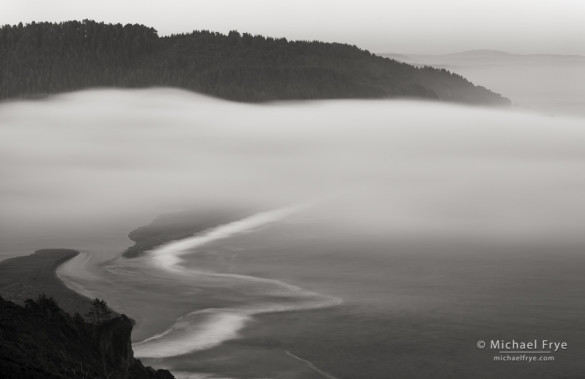
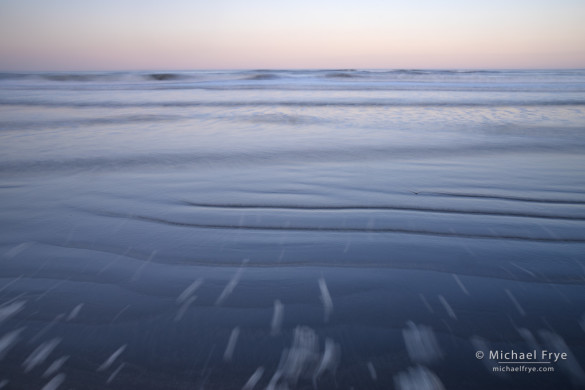
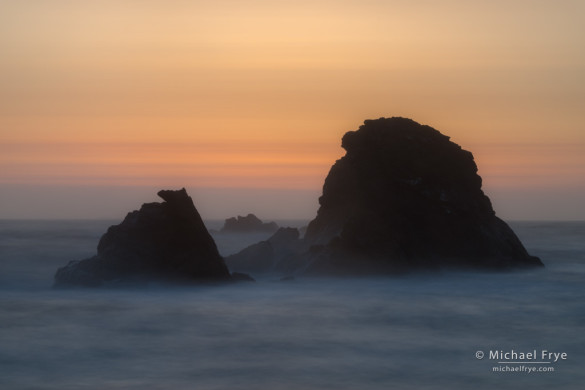
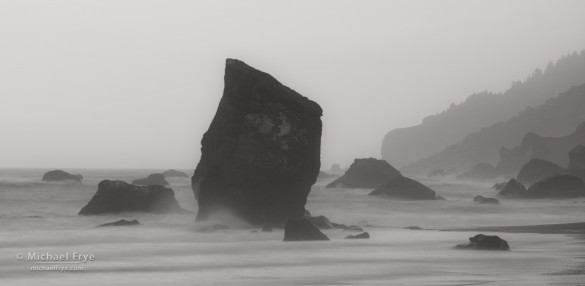
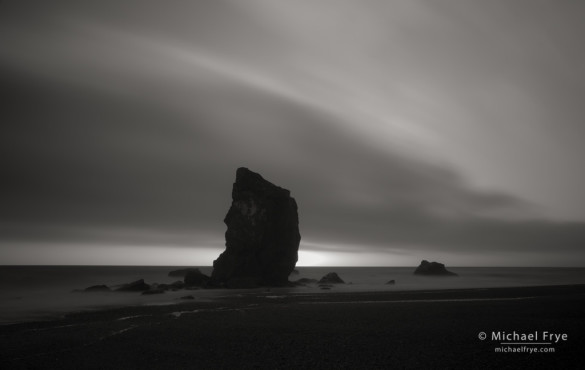
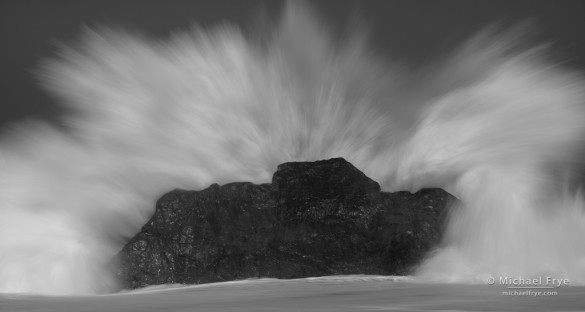
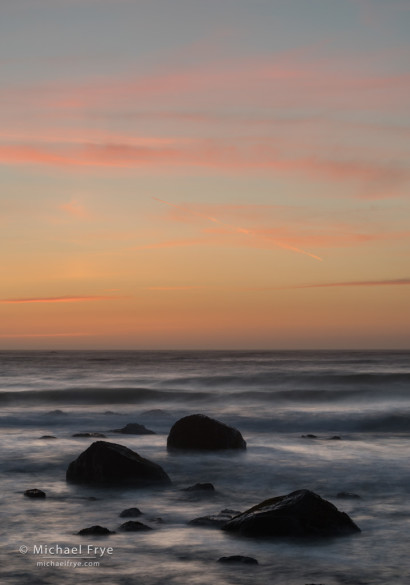
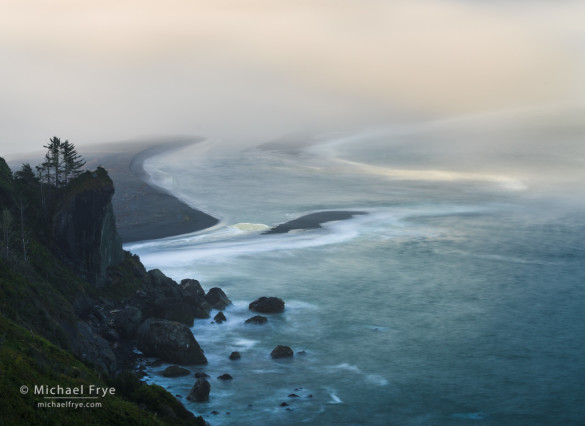








Really like the last image Michael, the colour palette suits the scene and the slow shutter has captured some nice wave shapes. I took a look at Roberts work, some wonderfully artistic renditions there. Thanks for posting
Thanks Peter, and I’m glad you took a look at Robert’s work!
What a wonderful workshop this must have been for your students—lots of information and insight!
You captured hauntingly beautiful scenes. As always, thanks for sharing your knowledge and adventure.
Thank you Ann! We all had a great time.
Good idea to have a workshop up there this time of year. What a nice cool place to play with shutter speeds and wind up with strong images like these. I like the subtle colors and all the movement. I’ll have to try longer shutter speeds on the ocean sometime. I usually photograph it fairly straight, but I like the effects you obtained here.
Thanks David! The timing of the workshop is for the rhododendrons, but it’s also the beginning of the fog season, which is a plus.
I really liked these images. Especially the wave hitting the rock. The timing on that one had to be tricky! The last image is also great. Nice and moody with lovely color. You always inspire me to try harder when I look at your images.
Thanks very much Nancy!
A great collection of photographs! I am a sucker of long exposure photographs, so it’s no surprise I am impressed with these. I tend to sometimes ignore faster shutter times as possibilities, which is a flaw, because as you say, every condition requires a different shutter time. It’s great that the photos here cover a wide range of shutter times. I should definitely visit the Californian coast at some point!
Thanks Camillo, and the California coast is beautiful if you get a chance to visit.
Very interesting post, I am greatly enjoying the silky water or clouds images, but have not started taking them myself yet. Need to finally do it. The reason I am commenting is I the very center composition of several images in this post- namely third, fourth and fifth from the bottom. Particularly for the fourt, I do not see how the composition is balances- perhaps you could comment a bit on those images and how they are composed and why it works in your opinion? I am struggling with the subject, and those images are against my gut feeling.
Well Iza, if those photos don’t seem balanced to you then nothing I say can convince you. Balance isn’t something you can be convinced of by logic; either the photo feels balanced to you or it doesn’t. For what it’s worth, with the fourth image from the bottom (“Sea stack at dusk), although the main focal point, the large sea stack, is left of center, it’s partially balanced by the smaller rock right of center, and by the arrow-shaped cloud that points to the right, leading the eye there. The third image from the bottom (“Crashing wave”) seems well-balanced to me, with a central rock, and lines radiating out from a central point. In the fifth image from the bottom (“Sea stack and mist”), the large sea stack just left of center also seems balanced to me by the rock and ridge lines to the right.
I did not want to sound confrontational. As I mentioned, I really struggle with balance, and I really wanted you to talk more about balance in those images how it feels for you. The “Crashing wave” seems indeed well balanced although it is centered. With “Sea stacks and mist” I would like to see more of the hills on the left. The more I look at the “Sea stacks at dusk” the more I agree that one is balanced, too, with the small rocks and vanishing point.